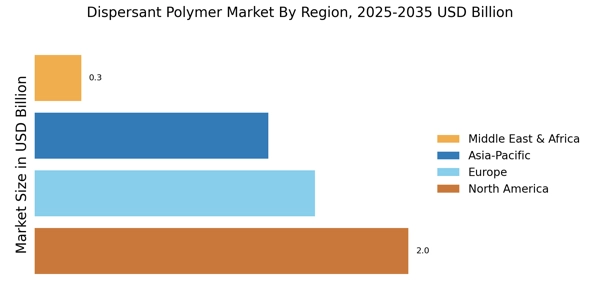Increased Regulatory Compliance
The Dispersant Polymer Market is also shaped by the growing emphasis on regulatory compliance and environmental standards. As governments implement stricter regulations regarding chemical safety and environmental impact, manufacturers are compelled to adopt eco-friendly dispersant polymers. This shift not only aligns with sustainability goals but also opens new market opportunities for bio-based and biodegradable dispersants. Market data indicates that the demand for environmentally compliant dispersant polymers is expected to rise, potentially leading to a market growth rate of 5% over the next few years. This trend reflects a broader industry movement towards sustainable practices, which is likely to influence product development and market dynamics.
Growth in the Oil and Gas Sector
The Dispersant Polymer Market is benefiting from the growth in the oil and gas sector, where dispersant polymers play a crucial role in drilling fluids and enhanced oil recovery processes. These polymers are essential for stabilizing suspensions and improving the efficiency of drilling operations. As exploration and production activities expand, particularly in offshore regions, the demand for effective dispersant solutions is likely to increase. Industry expert's suggest that the oil and gas segment could contribute significantly to the overall growth of the dispersant polymer market, with an anticipated growth rate of around 5% in the coming years. This trend underscores the vital role of dispersant polymers in supporting the energy sector.
Rising Demand in Paints and Coatings
The Dispersant Polymer Market is experiencing a notable increase in demand from the paints and coatings sector. This growth is primarily driven by the need for high-performance coatings that offer superior stability and dispersion of pigments. As the construction and automotive industries expand, the requirement for advanced coatings that enhance durability and aesthetic appeal becomes more pronounced. Market data indicates that the paints and coatings segment accounts for a substantial share of the overall dispersant polymer consumption, with projections suggesting a compound annual growth rate of approximately 5% over the next few years. This trend underscores the critical role of dispersant polymers in achieving desired product characteristics, thereby propelling the market forward.
Expansion in the Personal Care Sector
The Dispersant Polymer Market is witnessing significant growth due to the expanding personal care and cosmetics sector. Dispersant polymers are essential in formulating products such as shampoos, lotions, and makeup, where they enhance texture and stability. The increasing consumer preference for high-quality personal care products is driving manufacturers to incorporate advanced dispersant polymers into their formulations. Market analysis reveals that the personal care segment is projected to grow at a rate of around 6% annually, reflecting the rising demand for innovative and effective cosmetic solutions. This trend indicates a promising avenue for dispersant polymer applications, further solidifying their importance in the market.
Technological Innovations in Polymer Chemistry
The Dispersant Polymer Market is significantly influenced by ongoing technological innovations in polymer chemistry. Advances in formulation techniques and the development of new polymer types are enhancing the performance characteristics of dispersants. These innovations allow for better dispersion stability, lower viscosity, and improved compatibility with various substrates. As industries seek to optimize their processes and product quality, the demand for technologically advanced dispersant polymers is likely to increase. Recent studies suggest that the introduction of novel polymer formulations could lead to a market growth rate of approximately 4% in the coming years, highlighting the importance of research and development in driving the dispersant polymer market.


















Leave a Comment